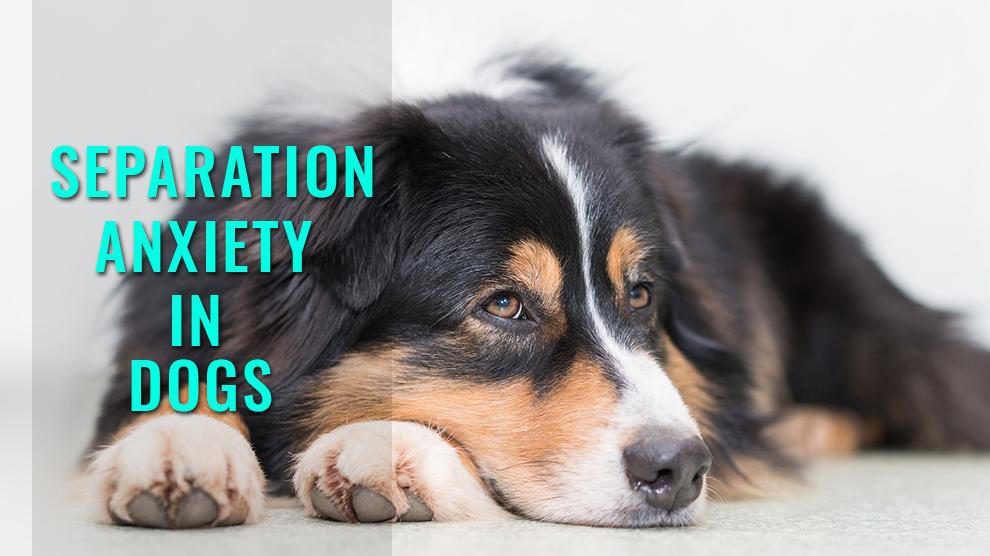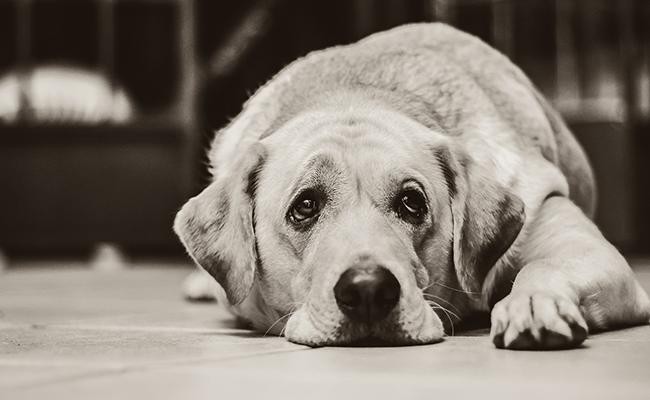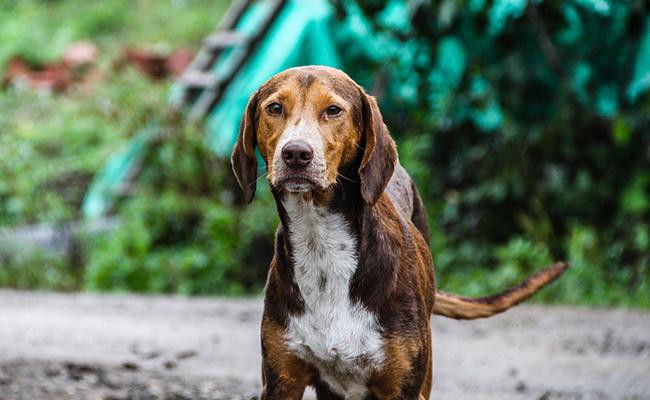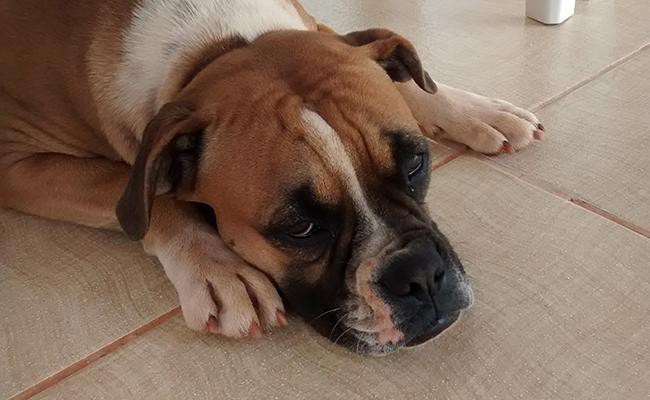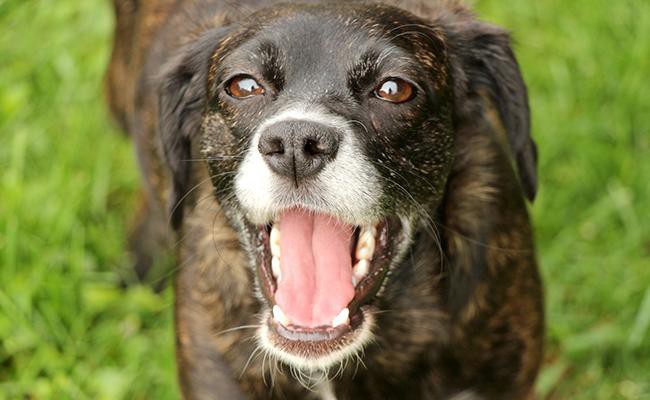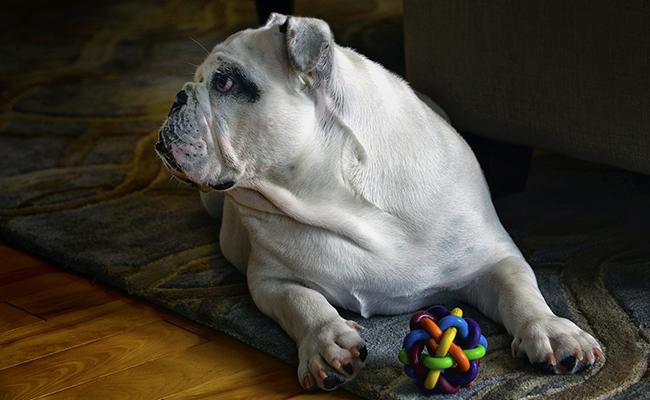- What Is Separation Anxiety In Dogs?
- What Causes Separation Anxiety In Dogs?
- Dog Separation Anxiety At Night
- Senior Dogs With Separation Anxiety
- Sun Downing In Dogs
- Separation Anxiety In Rescue Dogs
- Symptoms Of Separation Anxiety In Dogs
- How To Break Separation Anxiety In Dogs?
- Separation Anxiety Toys For Dogs
- Dog Training For Separation Anxiety
- Breeds With Separation Anxiety
- Dogs With Low Separation Anxiety
- Dog Breeds Without Separation Anxiety
Dog Pregnancy Calculator And Timeline
“Separation anxiety in dogs” is one of those terms that have crept its way from the medical literature into popular culture in recent times.
It is en vogue these days, especially among new dog trainers, to say that puppies and even adult dogs have separation anxiety just like humans.
However, keep in mind that a dog with true separation anxiety is different than a dog that follows you around at home, or a dogged pace when you reach for the car keys, scratch a few cushions while you’re out, but then relaxes.
Rather, this is a dog that works feverishly or that bloodies his paws from scratching at the entrance to escape and find you, and digs at his crate until his paws are swollen and red.
It’s this dog that whines, howls, bay, or woofs and makes sounds excessively all through your absence, and hyperventilates.
You may have even heard stories of dogs causing serious self-injury by anxiously chewing on a tailor and throwing themselves through plate glass windows.
If you’re embarrassed by your puppy’s anxious and wild behavior, keep in mind, you’re not alone. Separation anxiety and leash aggression are the topmost problems of this decade (according to experts).
What Is Separation Anxiety In Dogs?
Canine separation-related problems (SRP) (“separation anxiety disorder” or “separation distress”) are one of the most common reasons for a trip to the Vet or canine behaviorist.
Separation anxiety disorder is an example of behavioral anxiety and it comprises almost 40% of all canine cases seen by vets in the U.S. and Europe.
Situational anxiety is different from behavioral anxiety i.e. when your dog is afraid of something specific, like car rides, storms, or other loud noises or going to the vet or groomer.
It is estimated that up to 50-60% of the whole dog population may display clinical symptoms of separation-related problems at some point in their life.
They bark incessantly, leave accidents in conspicuous places and rip the house to shreds.
Actual separation anxiety is a dog in a state of panic about being left alone. These dogs have created a hyper-attachment to their master or a single individual.
SRP is a clinical term that can only be diagnosed only by a vet or canine behaviorist. Psychologically, it refers to a dog that has created a hyper-attachment to a single individual. If that person isn’t available, the dog presses the panic button.
Not all dogs find being home alone hard or have symptoms severe enough to result in injury. A dog who whines and barks throughout the absence of an individual is still suffering panic when left alone.
How To Fix Isolation Distress In Dogs?
“Isolation distress” symptoms are often the same as those of separation anxiety but with one major exception – a dog with isolation distress panics when left alone.
But it gets comfortable as long as they have a person to hang out with such as another family member or a trusted pet sitter or sometimes even another dog will fill the bill.
What Causes Separation Anxiety In Dogs?
We can often (though not always) identify the causes of a dog’s separation anxiety or isolation distress.
There is also a genetic component involved in some dogs that struggle with separation anxiety. Some dogs, due to genetic factors or breeding, are simply predisposed to isolation distress.
As pack animals, dogs love to hang out with their peers, and, when raised with humans, they view these individuals as their pack.
But some dogs form hyper-attachment with their two-legged friends. That’s when the trouble begins.
These dogs may ask for continuous reassurance by unceasingly leaning on their owners, climbing into their laps, and asking for attention.
What is going on in a lonely dog’s mind?
After an emotional goodbye, the owner leaves the dog alone. Your dog is perplexed.
After some time, the poor pooch thinks that he’s been abandoned. Now he’s really worried.
He tries to divert his mind by chewing on something convenient — the couch or carpet. But it doesn’t work and moreover, all these anxious moments give him an upset stomach.
He urinates on the carpet. Finally, he can take this any longer and begins to explode. “I gotta go out and find them!” So he starts frenetically digging at the doorway.
It’s not their fault or our fault that we live in a world that doesn’t permit us to keep them at our sides at all times!
Dog Separation Anxiety At Night
As mentioned, dogs are instinctual pack animals that join whatever the pack (in this case it’s your family) nearby.
The main cause for separation anxiety at night is dog owners rewarding bad behavior, whether unknowingly or on purpose.
When your dog is scratching at the door or whine in the other room, you react to such bad behavior with attention. This is called simulated separation anxiety.
Show your pet that bad behavior will not be rewarded and only give him attention when he remains calm after being left alone.
There are a few other causes of separation anxiety at night that can still affect a well-trained dog.
- Lack of exercise and mental stimulation during the day
- Changes in routine or new home
- Change of pet owners
- A new home
- Loss of a pet friend
Senior Dogs With Separation Anxiety
Sometimes separation anxiety is more related to the night time obscurity (SUNDOWNER’S SYNDROME) than to be left alone.
This is particularly prevalent among senior dogs and it is related to dementia or “canine cognitive dysfunction” (CCD).
Like many cases of dementia in humans, CCD in dogs is a result of the effects of aging of the brain.
Older Dog Separation Anxiety At Night
In older dogs, the effects of aging can the symptoms of sundowning. For a dog that is losing their sight and fading hearing senses, feeling confusion can surely become more anxious at night.
Of course, dogs have better night vision than humans but their night vision might not be as strong as they get old.
The darkness combined with loneliness and deteriorating senses can make old-timers nervous. Installing a night light for your dog near his sleeping place will give him enough vision to identify his surroundings.
Sun Downing In Dogs
As with humans even dogs do suffer restlessness in the evenings. As the light falls off, your dog may go spooked.
Sundowning In Dogs Symptoms
- Jittery behavior
- Barking
- Howling
- Drooling
There is no proper cure for sundowning in dogs. But, you can do certain things to help manage the symptoms of sundowning.
- Treatment or management of exacerbating conditions if possible.
- Use incontinence supplies (if needed) and Take potty breaks more often (if needed)
- Talk to your vet about dietary changes (for example, a diet higher in fatty acids) and same or melatonin use.
- Consult your vet about Anipryl, a prescription medication to slow the progression of CCD. It is worth looking into alternatives if Anipryl is not right for your dog. Other medications that are utilized for CCD include propentofylline, nicergoline, and adrafinil.
- DO NOT order these medications online without consulting with your vet.
Separation Anxiety In Rescue Dogs
The reasons for a rescue dog to experience separation anxiety are more obvious than a non-rescue dog.
To determine the severity of the SA issue or disorder, here are some questions to ask.
- How old is your dog now? When did you first notice the symptoms?
- Duration per day you generally spend with your dog?
- Does your dog follow you around everywhere you go throughout the day?
- Duration per day your dog is left alone?
- Was there a change in the location, family routine, or family structure?
- Does your dog greet you crazily when you’ve come home even after leaving for just a short while?
- Was there a disturbing event (such as health problems) that preceded the symptoms?
- Does your dog get nervous at night time?
- Was there an event, such as being home with you for a long period of time or a vacation spent together, after which your dog developed symptoms?
- Does your dog have an aversion to spending time outdoors?
- Does your dog follow you around everywhere you go throughout the day?
- What Happens Before You Leave the House?
Rescue Dog Separation Anxiety At Night
For some rescue dogs who suffered trauma previously, anxiety is a natural personality issue. they may destroy things, bays with high-pitched sound for hours, and scratch a lot. They may panic even if you try to crate them.
Preventing Separation Anxiety In Rescue Dogs
The principal approach is to leave the dog independent and be cool. Do not touch the dog frequently. Make some routines. Try making him understand the environment by giving him food treats and toys.
Teach some basic obedience commands for the situation. Provide him with some bright toys, maybe, squeaky ones, and a plush comfy bed. The final option is to take the advice of the vet for some antidepressant drugs.
Symptoms Of Separation Anxiety In Dogs
How long before you leave the house does your dog show signs of stress?
Correlate the correct chain of emotional events and signs that occur in your dog before you prepare to leave your home.
- growls/ whimpers/whining
- Panting
- Pacing
- Following you on your heels
- Other related signs
Signs Of Separation Anxiety In Dogs
What Happens After You Leave The House?
Find out what your dog does after you leave the house. “Sneak up” by Setting up a camera (you can use a free app like Skype, FaceTime, Zoom or a wireless device like a Nest) and leave the house.
Watch your dog’s behavior on a smartphone or simply by quietly peering from a window.
Check out the signs of your dog’s anxiety after you leave the house.
- Incessant barking or howling (but not boredom)
- Self-mutilation and Destructive behavior (but not boredom)
- Urination or Defecation in the house even though otherwise housetrained
- Scratching or Chewing at curtains, windows, doors, or other exit routes
- Recurring pacing
- Drooling, Wet coat, or sweating
- Immobility, such as sitting at the door the entire time you are away or staring out the window
If your dog has two or more of the above symptoms, a verdict of separation anxiety disorder is possible.
How To Break Separation Anxiety In Dogs?
- DAP Collar or diffuser –DAP (dog appeasing pheromones) are designed to calm your dog down in situations of high stress and anxiety.
- White noise machine or soothing instrumental music – When you turn on your chosen noise generator that will help to block out sounds from the outside world that may agitate your dog.
Music therapy CDs like ‘through a Dog’s Ear’ also can be used exactly for this purpose. - ThunderShirt – This looks like a doggie sweater but works by providing a gentle, maintained pressure that swaddles an anxious dog to relieve anxiety by engaging the parasympathetic nervous system.
If your dog has trouble with the Thundershirt, try the anti-anxiety SwaddleShirtinstead!
Medication for separation anxiety in dogs
Many dogs do not need medication to help prevail over their separation anxiety or isolation distress, but for some, it can make all the difference in the world.
Consult a veterinary behaviorist or an experienced Vet to learn more about the options that include meds like Xanax, Valium, Prozac, Lorazepam, or Paxil.
- Calming supplements – These dietary supplements are something between a vitamin and a satisfying non-sedative snack.
They are available as water additives, chewable tablets, or bone-shaped treats and help calm dogs without the nasty side effects. - Aromatherapy – This is another effective resource for dog anxiety treatment. Some fragrances are said to generate neonatal pheromones (reminding dogs of their mothers) and decrease anxiety.
Don’t apply the straight oil directly to their skin- Just spray a diluted mixture of water and oil on your dog’s fur.
Separation Anxiety – Violet Leaf, Neroli, Vetiver, Lavender, Rose hydrosol
Fear of Thunder and Fireworks – Rose Otto, Frankincense, Cornflower hydrosol, and Hops
General Anxiety – Violet Leaf, Frankincense, Roman Chamomile, Hemp, Linden Blossom
- Try homeopathic and herbal remedies – There are several herbal remedies that can help soothe your dog’s anxiousness. Homeopathic remedies are also effective because many are very specific and also very safe.
Aconite30C – It’s good for fear in general
Gelsemium (yellow jasmine) 6C or 30C – This remedy is often used for separation anxiety.
Pulsatillanigicans6C or 30C (Pasque-flower) – A good remedy for separation anxiety
Calcareaphosphorica6C or 30C (Calcium Phosphate) – For separation anxiety
Phosphorus30C – Good for all noise phobias
Separation Anxiety Toys For Dogs
Here are some of the best toys to ease separation anxiety in dogs:
- Treat-Dispensing Toys – A few good ones to use are the KONG Wobbler Dog Toy and Starmark Treat Dispensing Bob-a-Lot Dog Toy
- KONG Classic Dog Toy – The KONG Classic provides stimulation for hours. All you need to do is fill the hole in the center of the toy to stuff goodies or their special dog treat recipes, and your dog can spend lots of time chewing on the toy and try getting to the treat inside.
- Dog puzzle – With a dog puzzle, you can hide treats under the slides of a wooden puzzle like Nina Ottosson’s Brick Puzzle toy, and Trixie dog activity chess. Although it may sound complicated, a dog puzzle provides stimulation and make your dog work a little for a tasty reward.
- Ball toys – Teaser Ball, Nibble Pet Products Interactive Treat Dispensing Toy Ball Puzzle are a few good ones to use.
- Furbo Dog Camera – The Furbo Treat-Tossing Dog Camera allows you to interact with your fur baby and toss treats no matter how far away you are.
Through the companion iOS or Android app, you can get a live feed of your dog and dish out treats, and even snap photos.
Besides, you can also get alerts when a person comes into view, whether it is your pet sitter or a potential intruder. - Your old shoe and sweatshirt – Here’s a calming toy you won’t have to pay for. Offer one of your retired shoes and old worn-out shirts. Give them that old garment to nuzzle and snuggle.
Dog Training For Separation Anxiety
Before your training, remember you want to help your dog not just cope with separation anxiety, but learn to overcome it, more changes will be necessary.
The objective to help a dog overcome separation anxiety is to prevent them from panicking in the first place.
That is to say, your dog can’t be left alone at the start of discipline coaching.
At the outset, it’s significant to set up a baseline of constant company for these dogs. When that is not possible, there are many different options for preventing your dog from being alone.
A group dog walker or doggy daycare can make sure your dog is cared for while you are at work. Family members or friends may be willing to let your dog hang out with them during the day.
How To Train A Dog With Separation Anxiety?
- Find your dog’s separation threshold
- As you shut the door, start a stopwatch and watch for the SA symptoms- circling, whining, pacing, barking, howling, digging, jumping on the door, urination/defecation, and other indications of discomfort or separation anxiety.
- Figure out exactly when your dog starts to react – how long it takes for these anxious behaviors to start?, whether it’s the moment you’ve gone out (or even before you’ve started) or sometime after is your threshold.
- Determine pre-departure triggers
Also, figure out the pre-departure triggers or cues for your dog’s anxiety. For instance, does your dog start to pant or whine when he sees you put on your shoes?
How about when you pick up your keys? Note the list of the events that happen before you leave the home and make the list as comprehensive as possible. Weigh up each entry on the list, using a numerical scale like the one below:
- The dog does not seem to notice (Causes no anxiety)
- Dog notices but no problem
- The dog notices and tends to get alert
- Few signs of anxiety are observed in the dog, such as pacing or panting
- Many signs of anxiety observed in dog
Keep this list as your standard +threshold from STEP -1.
For triggers that got a 2 on this scale, try one or two repetitions a week of the desensitization protocol described below, just to make sure those events don’t develop into problems.
For triggers that are a 2 or higher, follow the protocol below until each item is a 1.
Systematic Desensitization For Separation Anxiety
This behavioral technique has been found to be successful in reducing or eliminating separation-related anxiety problems in dogs.
You can begin to slowly desensitize your pups to longer and longer absences as now you know your dog’s threshold.
This involves introducing the mild versions of the feared stimulus that will not evoke anxiety and gradually increasing the intensity of the feared stimulus for desensitization.
Desensitize individual pre-departure triggers
When you figured out exactly the time your dog starts to respond, For instance, does he react as soon as you put on your shoes or when you actually pick up the keys, or somewhere in between? You can start the desensitization process.
From the moment where your dog begins to get nervous, take a small step back and repeat the trigger behavior, depending on how your dog responds.
After doing the behavior 1-3 times at a level that is just below what your dog seems to find stressful, walk away and go back to doing whatever you normally do.
At random intervals throughout the day, deal with your dog’s pre-departure triggers separately1-3 times. When your dog seems to get anxious after a few of these short sessions, stop practicing and go about your day as usual.
Eventually, practice each of the triggers until each entry can be graded to a 1.
Combine pre-departure triggers
When your dog doesn’t worry about any of the individual pre-departure triggers, work on a combination of triggers.
Work as many possible pairs of triggers as you can and mix them in random order as much as possible, even if that does not seem logical. Keep track of your dog’s reaction, until your dog gets cool and composed about all of the different trigger combinations.
Overall systemic desensitization
Once you eradicated pre-departure triggers, start with a time period of 30 mins, and practice going to the door and stepping outside the house for variable periods of time. For instance, if your dog’s panic began the moment you walked out of the door, you may start with the steps below on day 1.
- Walk to the door and turn the doorknob. Do not open, release, and walk off.
- Walk to the door and open it [do not step outside]. Close the door and immediately return.
- Walk to the door and step outside, closing the door. Immediately open and come back.
Pause for at least a minute between steps to do something “normal” like straightening up, washing a dish, or watching a minute of TV.
Also, make sure not to pamper your dog too much during your pauses. You do have to disregard them completely; however, a small play session between these steps is going to make your next step more challenging.
Once your dog is fine with you stepping outside after the door is locked for a minute, increase your time outside in time increments. Then build up to 30 minutes duration in 5-10 minute increments.
When your dog remains calm after you are staying outside for 30 minutes, it’s possible that your dog can manage longer periods of absence.
However, it’s best to build up duration by about 10 or 15 minutes at a time until you are sure you can remain outside for longer periods of time.
Breeds With Separation Anxiety
Some dog breeds need a lot of attention and affection. They cannot be left alone for even a minimum span of time. They are likely to undergo a lot of anxiety when they are left alone.
- Labrador Retriever (English Lab, Black Lab, Silver Lab, Yellow Lab). They are social dogs and cannot be isolated for a longer period of time. All Labs become upset if their owners leave them at home alone.
- Cavalier King Charles Spaniel
- German Shorthaired Pointer
- Bichon Frise
- Jack Russell Terrier
- German Shepherd
- Australian Shepherd
- Toy poodle
- Vizsla
- Havanese
Dogs With Low Separation Anxiety
There are some dog breeds that do not mind much about being left alone. Some smaller size dog breeds are also less likely to suffer from separation anxiety.
- Basset Hound
- French Bulldog
- Chihuahua
- Greyhound
- Maltese
- Shar Pei
- Miniature Schnauzer
- Beagle
- Akita Inu and Shiba Inu
Dog Breeds Without Separation Anxiety
Some larger sized dogs do not suffer from separation anxiety. Some gentle and affectionate dogs have easy-going personalities and do not bother much about separation. They do not cause any destruction out of stress and are preferred dog breeds for working people.
- Chow Chow
- Basset hound
- Maltese
- Shiba Inu and Akita Inu
- Bullmastiff
- Dachshund
- Golden retriever
- Boston Terrier

